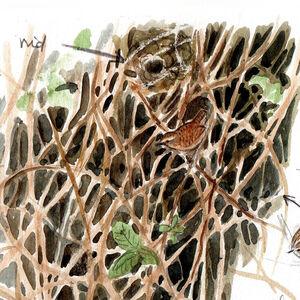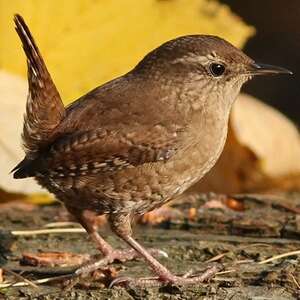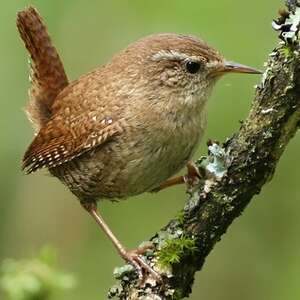Eurasian Wren
Troglodytes troglodytes - Troglodyte mignon
Identification
The Eurasian Wren is one of the smallest birds of the Old Continent. It measures less than 10 cm in length and weighs only about 8 g. Its wingspan is less than 5 cm. It has a very typical silhouette, with a round body and a large head with a long, slightly curved beak. Its tail is very short (3.5 cm) and is usually kept upright. Its short and round wings flap very quickly and its strong pink legs securely grasp onto whatever it is perched on. Both the male and female look identical. The upper parts are a warm brown color with tinges of brown in certain areas, especially on the tail and upper-tail coverts. A long light eyebrow overhangs the dark eye. The remiges and rectrices have distinct dark brown bars. The underside is beige-ochre with flanks that also have distinct bars. The juvenile only differs from the adult in a few minimal details of the plumage that can not be seen in the field. There is no possibility of confusion with any other species.
Subspecific information 28 subspecies
- Troglodytes troglodytes troglodytes (most of mainland Europe)
- Troglodytes troglodytes islandicus (Iceland)
- Troglodytes troglodytes borealis (Faroe Is.)
- Troglodytes troglodytes zetlandicus (Shetland Is.)
- Troglodytes troglodytes fridariensis (Fair I.. s of the Shetland Is..)
- Troglodytes troglodytes hirtensis (St Kilda I.. Outer Hebrides off w Scotland.)
- Troglodytes troglodytes hebridensis (Outer Hebrides except St. Kilda. off w Scotland.)
- Troglodytes troglodytes indigenus (Ireland and Britain)
- Troglodytes troglodytes kabylorum (nw Africa, Balearic Is. and s Spain)
- Troglodytes troglodytes koenigi (Corsica and Sardinia)
- Troglodytes troglodytes juniperi (ne Libya)
- Troglodytes troglodytes cypriotes (Cyprus, w and s Turkey to n Israel)
- Troglodytes troglodytes hyrcanus (Crimea, n Turkey, Caucasus and n, w Iran)
- Troglodytes troglodytes tianschanicus (ne Afghanistan to mountains of c Asia)
- Troglodytes troglodytes subpallidus (ne Iran to s Uzbekistan and nw Afghanistan)
- Troglodytes troglodytes magrathi (se Afghanistan and w Pakistan)
- Troglodytes troglodytes neglectus (w Himalayas)
- Troglodytes troglodytes nipalensis (c and e Himalayas)
- Troglodytes troglodytes idius (nc China)
- Troglodytes troglodytes szetschuanus (wc China)
- Troglodytes troglodytes talifuensis (s China and ne Myanmar)
- Troglodytes troglodytes dauricus (se Siberia, ne China, Korea and Tsushima. sw Japan.)
- Troglodytes troglodytes pallescens (Kamchatka Pen. and Commander Is.)
- Troglodytes troglodytes kurilensis (n Kuril Is.)
- Troglodytes troglodytes fumigatus (s Kuril Is., Sakhalin and Japan)
- Troglodytes troglodytes mosukei (Izu Is.)
- Troglodytes troglodytes ogawae (Yaku Shima and Tanegashima. off s Japan.)
- Troglodytes troglodytes taivanus (Taiwan)
Foreign names
- Troglodyte mignon,
- Chochín paleártico,
- carriça-eurasiática,
- Zaunkönig,
- ökörszem,
- Winterkoning,
- Scricciolo,
- gärdsmyg,
- Gjerdesmett,
- oriešok obyčajný,
- střízlík obecný,
- Gærdesmutte,
- peukaloinen,
- cargolet,
- Músarrindill,
- strzyżyk (zwyczajny),
- paceplītis,
- stržek,
- Крапивник,
- ミソサザイ,
- 鹪鹩,
- gärdsmyg,
- 鷦鷯,
Voice song and call
Perched prominently on a post, branch, log, rock or other structure, tail held up, head erect, he will proclaim his melodic phrases to the audience. Considering his size, the power of his song is astonishing. The phrase is very stereotypical and consistent within the species, and all males have the same repertoire. The song includes typical rolling syllables. The usual call is made up of repeated tjeks at a variable rhythm, faster when the bird is worried. Another frequent call is a dry, rolling trill, trrrrr.
Habitat
The Eurasian Wren is primarily a woodland species, which prefers damp deciduous and mixed forests, frequenting the lower stratum.
Behaviour character trait
The generic name Troglodytes comes from the nesting mode. For instance, the Eurasian Wren builds a nest in the shape of a ball with a side hole, which is very typical.
Since the nest is often set against a rocky wall or a wall, it looks like a troglodyte habitat. This bird is often called a wren in the countryside, wrongly of course because wrens are quite different birds. Not discouraged by its tiny size, the Eurasian Wren is an edgy and elusive bird, constantly on the move, which likes to make noise. And luckily for the observer since it prefers dense bushes where, otherwise, it would easily go unnoticed. Indeed, it is a snoop which spends most of its time on the ground or very close to it, exploring the litter, the banks and the tangles of rivers, piles of branches, wood stacks, in search of arthropods which it feeds on. In our gardens, we can see it exploring dense beds, the bottom of walls, compost heaps, all the untended places where the ground is covered with dead plant elements, which are hiding places for insects. In temperate climates, we can observe it all year round in its territory.Flight
Dietfeeding habits
Reproduction nesting
At the onset of spring, the male sets about constructing multiple nests in strategic places of his territory.
The composition of the nest varies slightly depending of local conditions, but overall two elements are dominant: moss and dead leaves associated with some twigs. It takes the form of a ball that is wider and especially deeper than it is high and has a lateral entrance hole sized for the bird, situated in its upper part. The entrance is slightly turned downwards and protected with a small overhang. The internal chamber, which is approximately 6 cm in diameter, is lined with soft elements. The nest is attached to its support and is often hooked up in ivy on a wall, rock, tree trunk or an interlaced tangle of riverbank roots eroded by a stream, a tree uprooted by the wind or a rocky crevice. A pile of branches or a pile of firewood can also do the trick. Some unusual situations can arise such as a nest built on top of another swallow's nest inside a barn or shed and wedged under the ceiling. It is up to the female to choose the nest in which she will lay her eggs. The clutch size is between five and seven white eggs spotted with reddish which she will incubate alone for a fortnight. The chicks, fed by both parents, leave the nest 15 to 17 days after hatching and will still be under their supervision for another 15 days. The species practices polygamy, which probably explains why males build multiple nests, with the hope of attracting multiple females. On the other hand, when the environmental conditions permit it, females will raise two successive broods.Geographic range
The Eurasian Wren is the only representative of its family on the Old Continent. It has two very close, almost identical cousins on the North American continent, the Eastern Wood-Wren to the east and the Baird's Wren to the west, which only recently have been specifically separated from it. Its distribution area is very large, as it stretches from Iceland to the Aleutians, that is, over the entire Eurasian continent and its extreme islands, at temperate latitudes. Area extensions to the north are observed at both ends, in Fenno-Scandia to the west and in Eastern Siberia to the east. The species also penetrates the African continent in the Maghreb and Cyrenaica. 28 subspecies share this vast area, subspecies that differ only by minor variations in the general brown tone. Birds of temperate areas are sedentary while those of the north are partially migratory.
Threats - protection
IUCN conservation status
concern
in the Wild
threatened
evaluated
The species is common and not threatened across almost its entire range. The population of the endemic subspecies from Fair Isle (T. t. fridariensis) does not exceed one hundred pairs and is thus vulnerable.
Sources of information
- IOC World Bird List (v15.1), Gill, F and D Donsker (Eds). 2025-12-07.
- Avibase, Lepage Denis
- HBW Alive,
- xeno-canto, Sharing bird sounds from around the world,
Other sources of interest
 Specification sheet created on
08/07/2023 by Jean François
Specification sheet created on
08/07/2023 by Jean FrançoisTranslation by AI Oiseaux.net
© 1996-2025 Oiseaux.net
- Accipitriformes
- Aegotheliformes
- Anseriformes
- Apodiformes
- Apterygiformes
- Bucerotiformes
- Caprimulgiformes
- Cariamiformes
- Casuariiformes
- Charadriiformes
- Ciconiiformes
- Coliiformes
- Columbiformes
- Coraciiformes
- Cuculiformes
- Eurypygiformes
- Falconiformes
- Galliformes
- Gaviiformes
- Gruiformes
- Leptosomiformes
- Mesitornithiformes
- Musophagiformes
- Nyctibiiformes
- Opisthocomiformes
- Otidiformes
- Passeriformes
- Pelecaniformes
- Phaethontiformes
- Phoenicopteriformes
- Piciformes
- Podargiformes
- Podicipediformes
- Procellariiformes
- Psittaciformes
- Pterocliformes
- Rheiformes
- Sphenisciformes
- Steatornithiformes
- Strigiformes
- Struthioniformes
- Suliformes
- Tinamiformes
- Trogoniformes

































